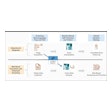Just in case you missed it, radiology residents really dislike breast imaging. That’s the word, once again, from a survey by Dr. Brian Englander at Thomas Jefferson Hospital in Philadelphia. Englander presented his work in a poster at the 2003 RSNA show earlier this month.
Englander sent a survey to 24 residents at TJU’s breast imaging center, receiving a response rate of 75%. Using a five-point scale for 20 questions, the participants were asked to rate their exposure to the range of breast imaging modalities, their perception of the specialty, and their expectations. A rating of 1 indicated that the resident was very dissatisfied; a 5 that the person was very satisfied.
"Residents were also asked to select their four main concerns about breast imaging," Englander wrote in his poster presentation. The responses were analyzed using the t-test.
The top reasons respondents gave for avoiding mammography included concerns about malpractice and litigation, as well as low reimbursement The next cited reason (14 responses) blamed the anxiety associated with the specialty and the "burnout" factor.
"There was also concern about public opinion and about the perception of breast imaging as a ‘soft’ specialty, and there was dissatisfaction with limitations in the rotation experience," Englander reported. In particular, the residents said they were not given enough exposure to alternative breast imaging modalities.
In more positive news, the residents did concede that they were satisfied with their exposure and level of training with breast ultrasound. This was because the majority of residents worked on cases that were diagnostic rather than screening, Englander told AuntMinnie.com.
The respondents also offered high marks for the skill levels of the attending physicians at TJU’s breast center (a score of 5) and expressed satisfaction with the degree of patient interaction (a score of 4).
Still, a full 80% of those surveyed said they would not consider a fellowship in breast imaging.
"As demands for breast imaging experts increase and the ability to recruit and retain faculty becomes increasingly difficult, it is necessary to find creative ways to encourage and motivate residents," Englander wrote. He suggested that allowing for more hands-on experience with other modalities, such as MRI and digital mammography, would be a first step in reviving residents' enthusiasm.
A second presentation at the RSNA show also found that residents were not adequately trained to perform screening mammography. Dr. Gillian Newstead and co-authors evaluated 20 radiology residents from two Chicago-based university training programs, five from each year. They were invited to participate in a screening exercise in which 100 four-view mammography screening studies were hung on a multiviewer. The dataset consisted of 45 women with 50 breast cancers and 55 women with normal mammograms.
"Participants were informed that this was an enriched dataset with approximately 50% breast cancers to be found," the researchers explained. "The residents reviewed the films independently and marked their findings with regard to lesion type and location on a standard form. The residents were also asked to indicate their level of suspicion for breast cancer on a 10-point scale."
In addition, this same database had been used in a previous exercise with 100 general radiologists and three breast imaging experts.
According to the results, senior residents (Year 4) turned in the best performance for cancer detection, with a mean sensitivity of 54%. Year 2 residents turned in a performance with a 48% mean sensitivity. The cancer detection rate for residents in Year 3 was 38%, and in Year 1 it was 33%. The comparable sensitivity for 100 radiologists reading the same cases was 72%, and 82% for the three experts.
The lower performance of residents in comparison with the experienced readers most likely reflected a lack of sufficient exposure and formal training in breast cancer screening, Newstead and co-authors wrote.
"This is significant, as many residents who have just finished their training are expected to read screening mammography studies upon entering their first jobs. The sample size is small, but indicates further scrutiny of this potentially significant problem is warranted, along with development of programmatic changes in screening training and periodic assessment measures during the training program," they concluded.
By Shalmali Pal
AuntMinnie.com staff writer
December 15, 2003
Related Reading
Bringing residents back to breast imaging: An insider’s perspective, October 16, 2003
Malpractice fears may initiate more false-positive mammograms in North America, September 16, 2003
Making mammographers better: The last link in the imaging chain, August 29, 2003
Radiology residents not interested in reading mammograms, June 9, 2003
Copyright © 2003 AuntMinnie.com



















